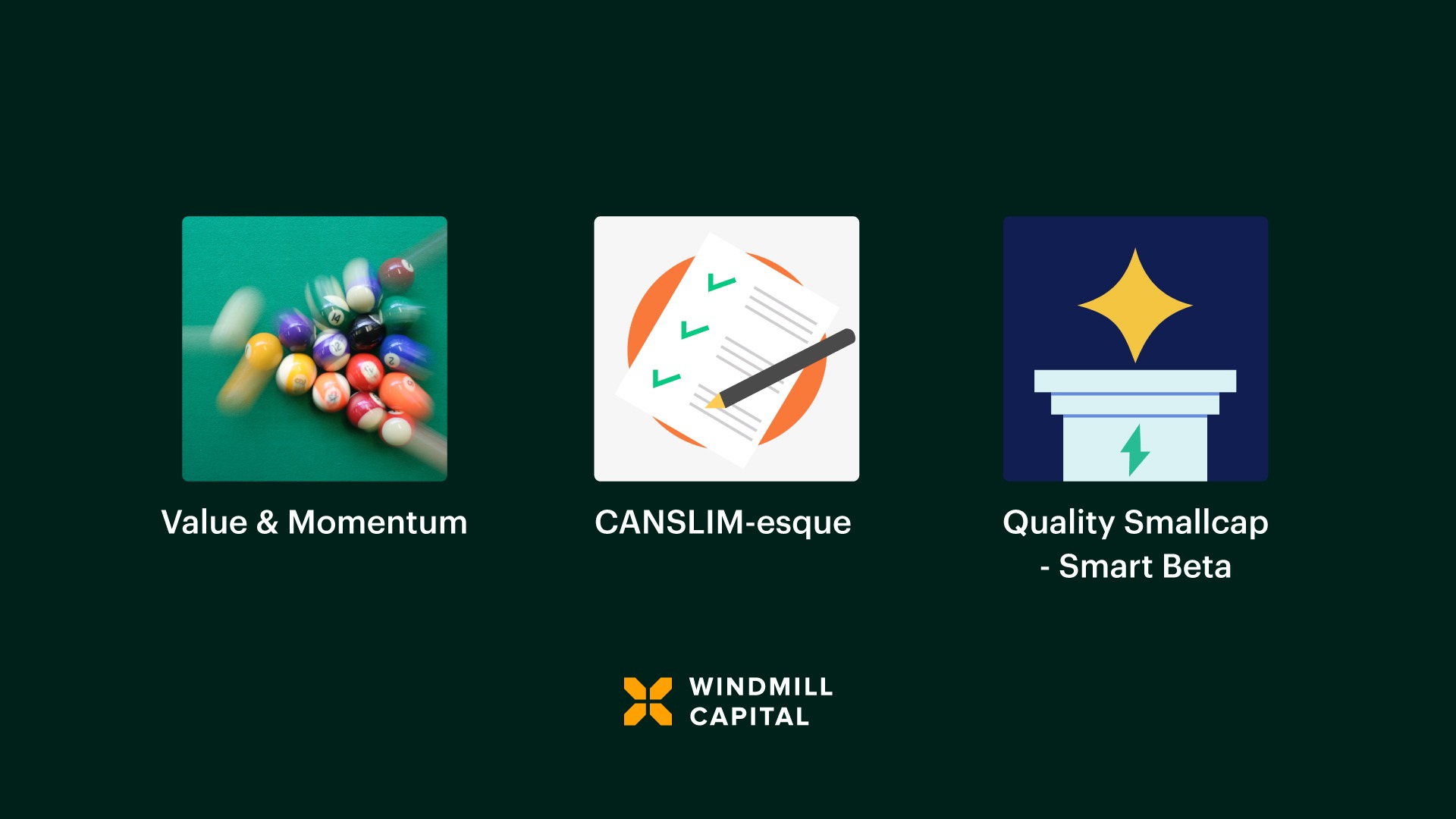smallcases in focus: Momentum smallcases, Part 2

Russia – Ukraine war, fears of recession in the US and global supply chain issues leading to a surge in inflation and consequent interest rate hike by Central banks around the world caused Indian stock markets to go through a bear phase between Oct 21 – June 22. Nifty 50, dropped by ~17% during this period. Subsequently, a marginal drop in oil prices and stabilization of inflation has contributed to market momentum resulting in a ~18% jump in Nifty 50.
As explained in our Sept newsletter, momentum investing is the technique of buying/selling stocks based on the strength of recent stock market trends. It is based on the assumption that, if the price of a stock has enough momentum, it will continue to rise. While the usual refrain in the market is to “buy low and sell high”, momentum investing aims to “buy high and sell higher”.
Windmill Capital has multi-factor smallcases, Quality Smallcap – Smart Beta, Value & Momentum and Canslim-esque where momentum is the primary screening criteria. In addition, these smallcases also include other screening criteria that provide exposure to factors like quality, value and growth.
Specific sectors have been driving the price performance of these smallcases recently. Lets deep dive into these sectors to understand what factors are driving their performance.

Capital Goods
The capital goods sector, with a market size of $43 bn, is an essential component of the manufacturing industry and has a 12% share of the latter. It consists of sub-sectors such as heavy electrical equipment, process plant equipment, earthmoving/mining machinery etc.
Since mid-June ’22, the S&P BSE Capital Goods index is up ~32%. The major reason for this jump is the marked uptick in tendering activity in sectors such as transmission & distribution and railways. This in turn is driven by the steep jump in public investments by the Government and the resulting capex upcycle trend. The ratio of gross fixed capital formation to GDP rose to 32.5% in FY22 up from 28% recorded in FY21. For FY23, the Government has budgeted for a capex growth of 25%. The Center’s capex rose by 62.5% on a year-on-year basis in the April-July 22 period, with roads and highways, railways and defense being the top three investment areas. Schemes such as National Monetisation Pipeline, Gati Shakti and PLI are all expected to help in the recovery of the capex cycle of the economy.
Private companies had been deleveraging for the last few years. This and the improvement in capacity utilization levels of factories to 75% has set the ground for investment in the capex cycle. Capex by private companies has also started rebounding. It was up 22% in FY22 following a decline in the previous year. Recent fall in global commodity prices resulting in the easing of input prices will also support investment uptick, resulting in improved order inflows for capital goods companies.
Mazagon Dock Shipbuilders, Bharat Electronics, Ingersoll-Rand (India), Apar Industries, Craftsman Automation and Bharat Dynamics are some of the best performers in this space since mid June ‘22. These companies have been a part of the above mentioned smallcases and have generated average returns of 44% since mid June, post the broader market turnaround.
Banks
The Nifty Banking index is up 26.1% since mid-June ’22. Multiple factors have been driving the performance of the index.
- The sector has been witnessing buoyant credit growth, driven by demand from the retail and SME segment. Loan growth for April – June’22 period was at 15.4% year on year (YOY) albeit on a lower base of the previous fiscal. The momentum has continued for non-food bank credit growth. The YOY growth numbers were 15.1% and 16.0% for July’22 and Aug’22 respectively.
- The asset quality trend also continued to improve led by healthy recoveries and steady incremental slippages. According to news reports, the overall NPA ratio declined to 5.7% during April – June’22 period from 7.5% a year ago. Asset quality improved across all the major sectors. Improving asset quality leads to a drop in provisioning thereby boosting net profitability.
- Repo rate hikes are considered negative for the banking industry. When repo rates are increased, loans become more expensive leading to lower credit growth. At the same time, the deposit rate increases and more people are keen to deposit their money in the banks. This usually negatively affects profit margins. RBI has hiked repo rates by 190 bps since May’22 and the rate currently stands at 5.9%. According to a KR Choksey report, banks have been able to pass on the repo rate hike by increasing the rate of floating loans. These loans constitute about 65% of the total loan book of the banks. Banks have also only meagerly raised their deposit rates. This has translated into an impressive growth in margins of private sector banks during the July – Sept’22 quarter.
- According to news reports, higher net interest income and robust loan growth also combined to push up the net profit growth of private sector banks during the July- Sept’22 quarter.
Two such banks which have witnessed tailwinds from the above mentioned factors and have been a part of the above mentioned smallcases are ICICI Bank and Canara Bank. They have generated 32.3% & 60.6% respectively since mid June, post the broader market turnaround.
Metals & Mining
India has large reserves of Iron ore, Bauxite, Chromium, Manganese ore, Baryte, Rare earth and Mineral salts. The country mined ~$20.78 bn worth of minerals during the FY21 period. It is the 2nd largest producer of crude steel in the world with 120 MT of crude steel produced during FY22. High demand for metals from infra and auto segments, relaxed FDI norms, and increasing private participation have all been driving the growth of the metals and mining sector.
The Nifty Metal index has surged 24.8% since mid-June ’22.
Since different end-user industries affect distinct sub-sectors of the metal sector in contrasting ways it is difficult to provide a holistic commentary about the sector. Let us deep dive into specific companies and understand the levers which have been pushing up their price.
APL Apollo Tubes
The company makes steel tubes and pipes. Its products are used in various applications like agricultural and plumbing, fire fighting, metros, solar panels etc. It is part of the Canslim-esque smallcase and has generated 25.9% since mid-June.
The company reported its highest ever quarterly sales volume during July – Sept ‘22 quarter. During this period, sales volume rose by 41% on YoY basis and 42% on QoQ basis, fueled by increased demand for general structure tubes. Overall 1HFY23 volume grew 28% on YoY basis. The company’s upcoming plant in Chhattisgarh is expected to be fully operational during the current quarter and will increase the annual capacity by another 57%.
Welspun Corp Ltd, Ramkrishna Forgings, & Coal India
These companies are part of the Value & Momentum smallcase.
Welspun Corp manufactures welded pipes, rolled steel plates and coils. Its products find application in oil & gas, water industry and structurals. It has manufacturing facilities in India, USA and Saudi Arabia.
In July, Welspun’s associate company received an order of around Rs 689 crore from Saline Water Conversion Corporation in Saudi Arabia. In Sept, the company secured a significant order for a carbon capture pipeline project in the United States. As of Aug 2022, Welspun’s global order book stands at Rs.13,400 crore and majority of this is expected to be executed in FY23.
Ramkrishna Forgings is engaged in the sale of forged components. It supplies its products to various sectors such as automotive, railways, farm equipment, oil & gas, mining etc.
During July – Sept ‘22 quarter the company’s total revenue jumped up by 42% on a YOY basis aided by volume growth. Drop in interest expense led to 52% jump in EPS on a YOY basis. During H1FY23, the company won 5 new contracts worth Rs.408 crore. According to management commentary, strong recovery in OEM volumes across board and China + 1 strategy is expected to result in strong order wins across geographies during H2FY22.
Coal India Ltd (CIL) is a Maharatna PSU and is the largest coal producer in the world. It contributes to 85% of total domestic coal production and 55% of total power generation.
For the first five months of FY23 (April–August 2022), CIL has achieved production volume of 253.3 MT (up 21.1% YoY). For FY23, CIL has maintained its production target of 700 MT. The company plans to achieve coal production of ~900 MT by FY25. For FY22, CIL incurred a capex of Rs.15,401 cr against the targeted capex of Rs.14,685 cr. For FY23, the company is targeting capex to the tune of Rs.16,500 cr. Analysts expect dependence on domestic coal to remain strong and e-auction premiums to remain elevated in FY23. This is likely to result in a better FY23, both in terms of volumes and prices for CIL.
These companies together have generated an average return of 29.5% since mid June ‘22.
The aforementioned sectors have witnessed increased investor participation on the back of a possible upcycle ahead. Since the primary criterion of the 3 smallcases is to select quality stocks displaying strong price momentum, companies like ICICI Bank, Bharat Dynamics, Coal India etc. get included regularly. It is important to note that these smallcases will select stocks from such sectors which are either witnessing a turnaround or in a bullish phase. In the future, new sectors will emerge as the winners and stocks from such sectors will be included.




